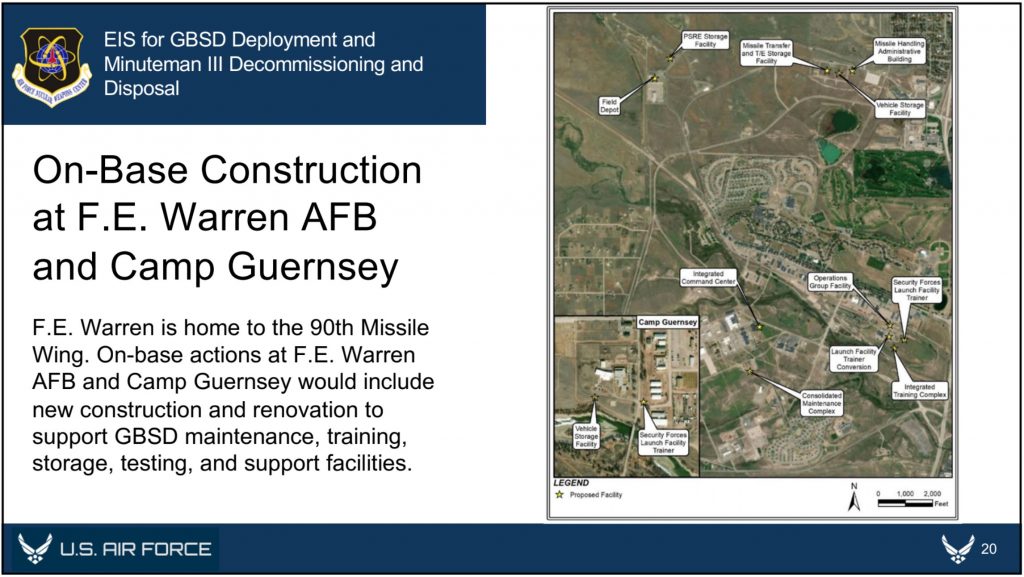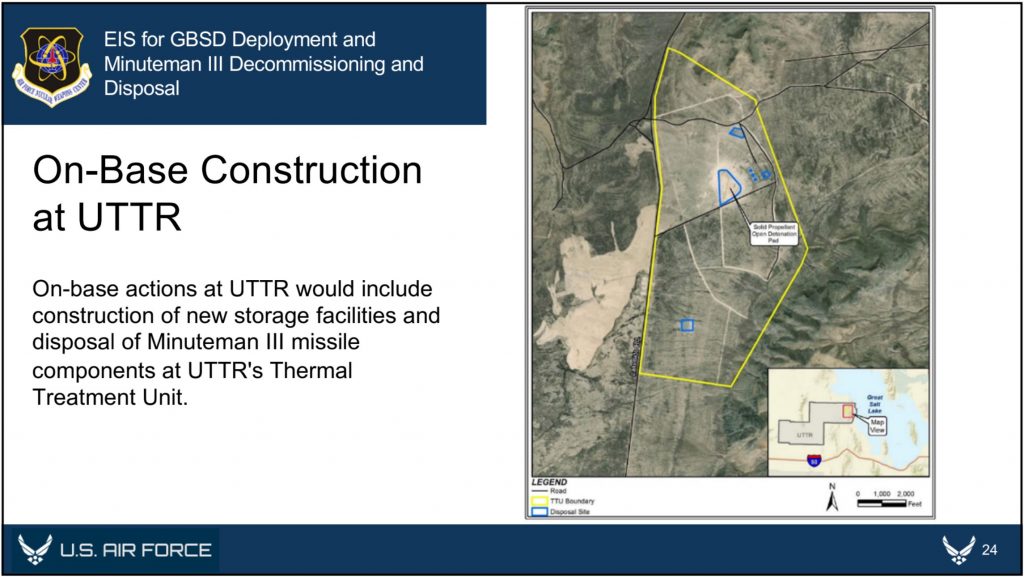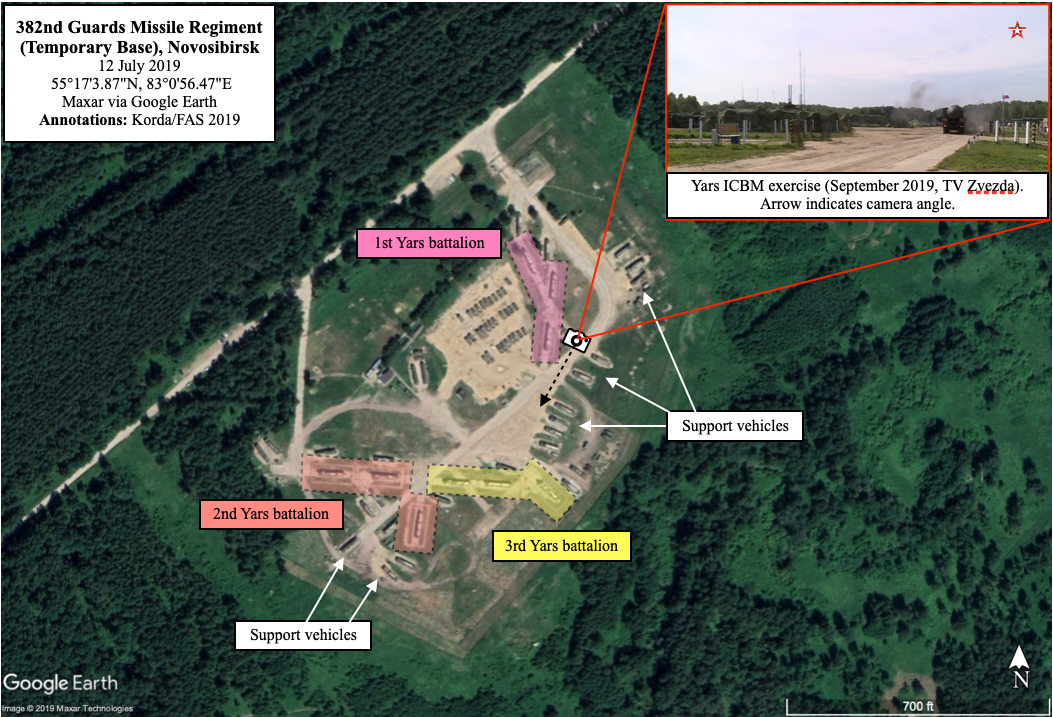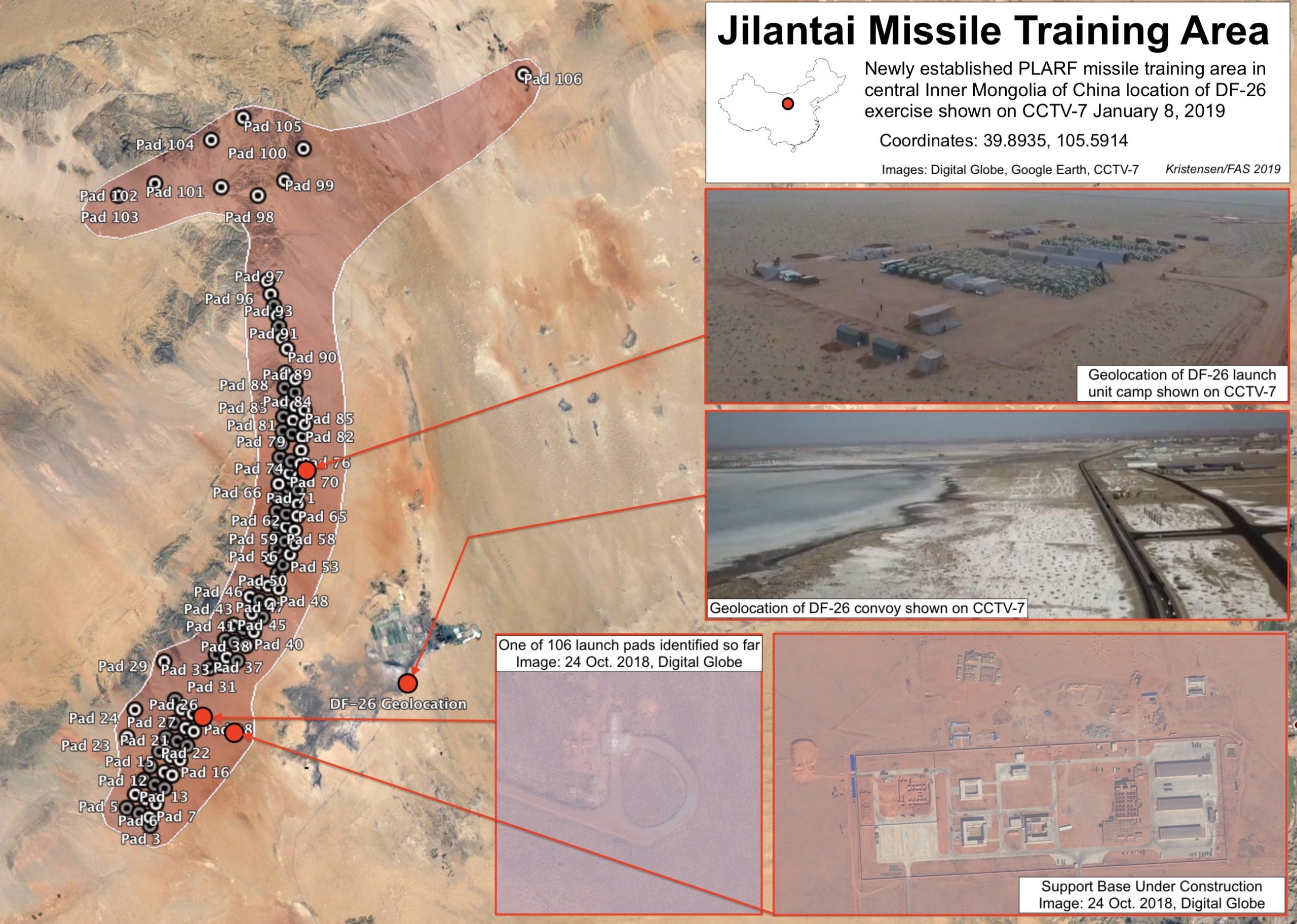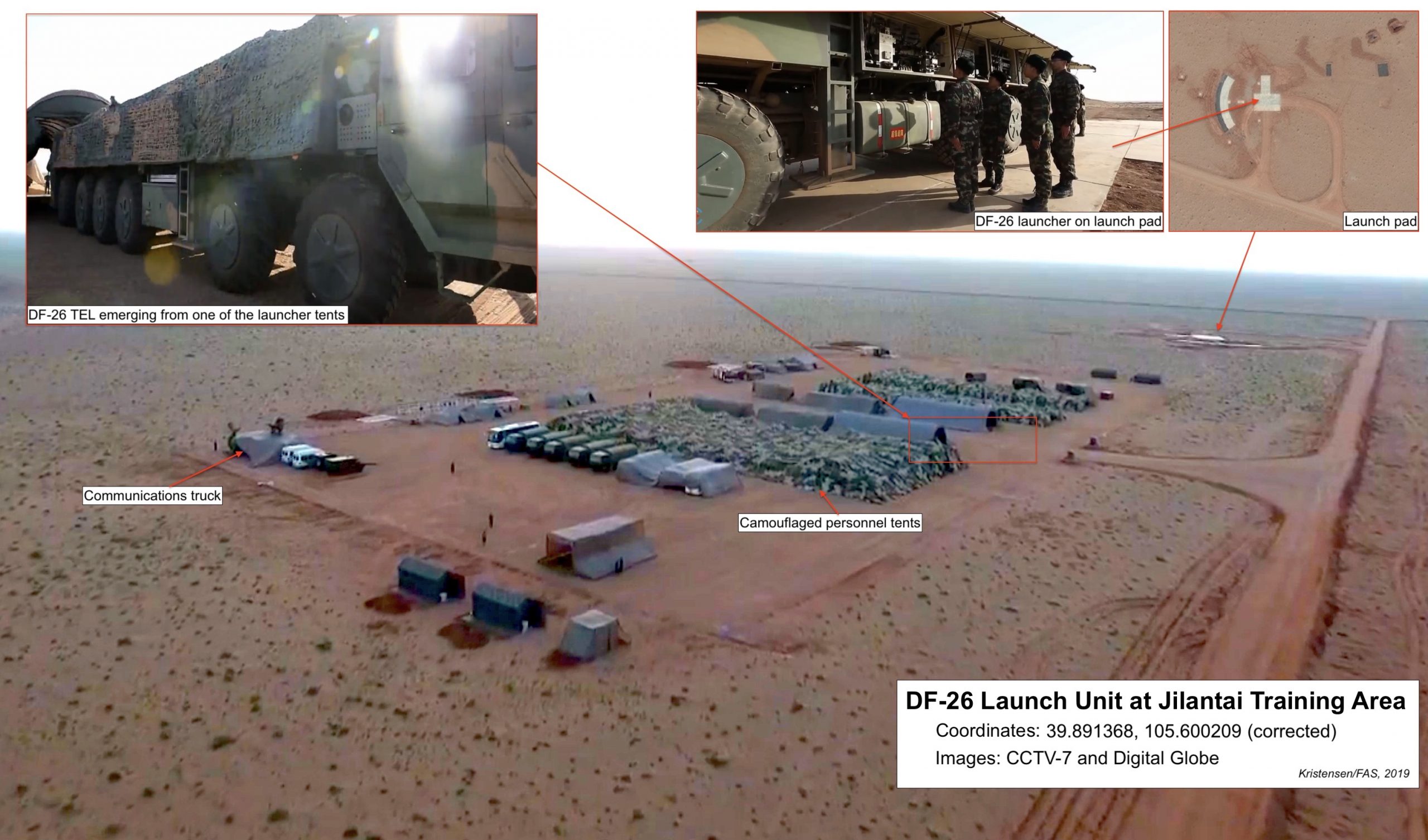New Environmental Assessment Reveals Fascinating Alternatives to Land-Based ICBMs
A new Air Force environmental assessment reveals that it considered basing ICBMs in underground railway tunnels––or possibly underwater.

Map of the ICBM missile fields contained within the Air Force’s July 2022 assessment.
On July 1st, the Air Force published its Draft Environmental Impact Statement (EIS) for its proposed ICBM replacement program, previously known as the Ground-Based Strategic Deterrent (GBSD) and now by its new name, “Sentinel.” The government typically conducts an EIS whenever a federal program could potentially disrupt local water supplies, transportation, socioeconomics, geology, air quality, and other related factors.
A comprehensive environmental assessment is certainly warranted in this case, given the tremendous scale of the Sentinel program––which consists of a like-for-like replacement of all 400 Minuteman III missiles that are currently deployed across Colorado, Montana, Nebraska, North Dakota, and Wyoming, plus upgrades to the launch facilities, launch control centers, and other supporting infrastructure.

Cover page of the Air Force’s July 2022 Draft Environmental Impact Statement for the GBSD.
The Draft EIS was anxiously awaited by local stakeholders, chambers of commerce, contractors, residents, and… me! Not because I’m losing sleep about whether Sentinel construction will disturb Wyoming’s Western Bumble Bee (although maybe I should be!), but rather because an EIS is also a wonderful repository for juicy, and often new, details about federal programs––and the Sentinel’s Draft EIS is certainly no exception.
Interestingly, the most exciting new details are not necessarily about what the Air Force is currently planning for the Sentinel, but rather about which ICBM replacement options they previously considered as alternatives to the current program of record. These alternatives were assessed during in the Air Force’s 2014 Analysis of Alternatives––a key document that weighs the risks and benefits of each proposed action––however, that document remains classified. Therefore, until they were recently referenced in the July 2022 Draft EIS, it was not clear to the public what the Air Force was actually assessing as alternatives to the current Sentinel program.
Missile alternatives
The Draft EIS notes that the Air Force assessed four potential missile alternatives to the current plan, which involves designing a completely new ICBM:
- Reproducing Minuteman III ICBMs to “existing specifications” by washing out and refilling the first- and second-stage rocket boosters; remanufacturing the third stages and Propulsion System Rocket Engine––the ICBM’s post-boost vehicle; and refurbishing and replacing all other subsystems;
The Air Force appears to have ultimately eliminated all four of these options from consideration because they did not meet all of their “selection standards,” which included criteria like sustainability, performance, safety, riskiness, and capacity for integration into existing or proposed infrastructure.
Of particular interest, however, is the Air Force’s note that the Minuteman III reproduction alternative was eliminated in part because it did not “meet the required performance criteria for ICBMs in the context of modern and evolving threats (e.g., range, payload, and effectiveness.” It is highly significant to state that the Minuteman III cannot meet the required performance criteria for ICBMs, given that the Minuteman III currently performs the ICBM role for the US Air Force and will continue to do so for the next decade.
This statement also suggests that “modern and evolving threats” are driving the need for an operationally improved ICBM; however, it is unclear what the Air Force is referring to, or how these threats would necessarily justify a brand-new ICBM with new capabilities. As I wrote in my March 2021 report, “Siloed Thinking: A Closer Look at the Ground-Based Strategic Deterrent,”
“With respect to US-centric nuclear deterrence, what has changed since the end of the Cold War? China is slowly but steadily expanding its nuclear arsenal and suite of delivery systems, and North Korea’s nuclear weapons program continues to mature. However, the range and deployment locations of the US ICBM force would force the missiles to fly over Russian territory in the event that they were aimed at Chinese or North Korean targets, thus significantly increasing the risk of using ICBMs to target either country. Moreover, […] other elements of the US nuclear force––especially SSBNs––could be used to accomplish the ICBM force’s mission under a revised nuclear force posture, potentially even faster and in a more flexible manner. […] It is additionally important to note that even if adversarial missile defenses improved significantly, the ability to evade missile defenses lies with the payload––not the missile itself. By the time that an adversary’s interceptor was able to engage a US ICBM in its midcourse phase of flight, the ICBM would have already shed its boosters, deployed its penetration aids, and would be guided solely by its reentry vehicle. Reentry vehicles and missile boosters can be independently upgraded as necessary, meaning that any concerns about adversarial missile defenses could be mitigated by deploying a more advanced payload on a life-extended Minuteman III ICBM.”
Of additional interest is the passage explaining why the Air Force dismissed the possibility of using the Trident II D5 SLBM as a land-based weapon:
“The D5 is a high-accuracy weapon system capable of engaging many targets simultaneously with overall functionality approaching that of land- based missiles. The D5 represents an existing technology, and substantial design and development cost savings would be realized; but the associated savings would not appreciably offset the infrastructure investment requirements (road and bridge enhancements) necessary to make it a land-based weapon system. In addition, motor performance and explosive safety concerns undermine the feasibility of using the D5 as a land-based weapon system.”
The Air Force’s concerns over road and bridge quality are probably justified––missiles are incredibly heavy, and America’s bridges are falling apart at a terrifying rate. However, it is unclear why the Air Force is not confident about the D5’s motor performance, given that even aging Trident SLBMs have performed very well in recent flight tests: in 2015 the Navy conducted a successful Trident flight test using “the oldest 1st stage solid rocket motor flown to date” (over 26 years old), with 2nd and 3rd stage motors that were 22 years old. In January 2021, Vice Admiral Johnny Wolfe Jr.––the Navy’s Director for Strategic Systems Programs––remarked that “solid rocket motors, the age of those we can extend quite a while, we understand that very well.” This is largely due to the Navy’s incorporation of nondestructive testing techniques––which involve sending a probe into the bore to measure the elasticity of the propellant––to evaluate the reliability of their missiles.
As a result, the Navy is not currently contemplating the purchase of a brand-new missile to replace its current arsenal of Trident SLBMs, and instead plans to conduct a second life-extension to keep them in service until 2084. However, the Air Force’s comments suggest either a lack of confidence in this approach, or perhaps an institutional preference towards developing an entirely new missile system. [Note: Amy Woolf helpfully offered up another possible explanation, that the Air Force’s concerns could be related to the ability of the Trident SLBM’s cold launch system to perform effectively on land, given that these very different launch conditions could place additional stress on the missile system itself.]
Basing alternatives
The Draft EIS also notes that the Air Force assessed two fascinating––and somewhat familiar––alternatives for basing the new missiles: in underground tunnels and in “deep-lake silos.”
The tunnel option––which had been teased in previous programmatic documents but never explained in detail––would include “locating, designing, excavating, developing, and installing critical support infrastructure such as rail systems and [launch facilities] for an array of underground tunnels that would likely span hundreds of miles”––and it is effectively a mashup of two concepts from the late Cold War.
The rail concept was strongly considered during the development of the MX missile in the 1980s, although the plan called for missile trains to be dispersed onto the country’s existing civilian rail network, rather than into newly-built underground tunnels. Both the rail and tunnel concepts were referenced in one of my favourite Pentagon reports––a December 1980 Pentagon study called “ICBM Basing Options,” which considered 30 distinct and often bizarre ICBM basing options, including dirigibles, barges, seaplanes, and even hovercraft!

Illustrations of “Commercial Rail” concept from 1980 Pentagon report, “ICBM Basing Options.”
The second option––basing ICBMs in deep-lake silos––was also referenced in that same December 1980 study. The concept––nicknamed “Hydra”––proposed dispersing missiles across the ocean using floating silos, with “only an inconspicuous part of the missile front end [being] visible above the surface.” Interestingly, this raises the theoretical question of whether the Air Force would still maintain control over the ICBM mission, given that the missiles would be underwater.

Illustration of “Hydra” concept from 1980 Pentagon report, “ICBM Basing Options.”
When considering alternative basing modes for the Sentinel ICBM, the Air Force eliminated both concepts due to cost prohibitions, and, in the case of underwater basing, a lack of confidence that the missiles would be safe and secure. This concern was also floated in the 1980 study as well, with the Pentagon acknowledging the likelihood that US adversaries and non-state actors “would also be engaged in a hunt for the Hydras. Not under our direct control, any missile can be destroyed or towed away (stolen) at leisure.”
Another potential option?
In addition to revealing these fascinating details about previously considered alternatives to the Sentinel program, the Draft EIS also highlighted a public comment suggesting that “the most environmentally responsible option” would simply be the reduction of the Minuteman III inventory.
The Air Force rejected the comment because it says that it is “required by law to accelerate the development, procurement, and fielding of the ground based strategic deterrent program;’” however, the public commenter’s suggestion is certainly a reasonable one. The current force level of 400 deployed ICBMs is not––and has never been––a magic number, and it could be reduced further for a variety of reasons, including those related to security, economics, or a good faith effort to reduce deployed US nuclear forces. In particular, as George Perkovich and Pranay Vaddi wrote in a 2021 Carnegie Endowment for International Peace report, “This assumption that the ICBM force would not be eliminated or reduced before 2075 is difficult to reconcile with U.S. disarmament obligations under Article VI of the Nuclear Non-Proliferation Treaty.”
The security environment of the 21st century is already very different than that of the previous century. The greatest threats to Americans’ collective safety are non-militarized, global phenomena like climate change, domestic unrest and inequality, and public health crises. And recent polling efforts by ReThink Media, the Union of Concerned Scientists, and the Federation of American Scientists suggest that Americans overwhelmingly want the government to invest in more proximate social issues, rather than on nuclear weapons. To that end, rather than considering building new missile tunnels, it would likely be much more domestically popular to spend money on domestic priorities––perhaps new subway tunnels?
—
Background Information:
- “Siloed Thinking: A Closer Look at the Ground-Based Strategic Deterrent,” Federation of American Scientists (Mar. 2021)
- “Environmental Assessment Reveals New Details About the Air Force’s ICBM Replacement Plan,” Federation of American Scientists (Nov. 2020)
- ICBM Information Project, Federation of American Scientists
This publication was made possible by generous support from the John D. and Catherine T. MacArthur Foundation, the New-Land Foundation, Ploughshares Fund, the Prospect Hill Foundation, and Longview Philanthropy. The statements made and views expressed are solely the responsibility of the author.
Flying Under The Radar: A Missile Accident in South Asia

A crashed Indian missile inside Pakistani territory. Image: Pakistan Air Force.
With all eyes turned towards Ukraine these past weeks, it was easy to miss what was almost certainly a historical first: a nuclear-armed state accidentally launching a missile at another nuclear-armed state.*
On the evening of March 9th, during what India subsequently called “routine maintenance and inspection,” a missile was accidentally launched into the territory of Pakistan and impacted near the town of Mian Channu, slightly more than 100 kilometers west of the India-Pakistan border.
Because much of the world’s attention has understandably been focused on Eastern Europe, this story is not getting the attention that it deserves. However, it warrants very serious scrutiny––not only due to the bizarre nature of the accident itself, but also because both India’s and Pakistan’s reactions to the incident reveal that crisis stability between South Asia’s two nuclear rivals may be much less stable than previously believed.
The Incident
Using official statements and open-source clues, it is possible to piece together a relatively complete picture of what took place on the evening of March 9th.
At 18:43:43 Pakistan Standard Time (19:13:43 India Standard Time), the Pakistan Air Force picked up a “high-speed flying object” 104 kilometers inside Indian territory, near Sirsa, in the state of Haryana. According Air Vice Marshal Tariq Zia––the Director General Public Relations for the Pakistan Air Force––the object traveled in a southwesterly direction at a speed between Mach 2.5 and Mach 3. After traveling between 70 and 80 kilometers, the object turned northwest and crossed the India-Pakistan border at 18:46:45 PKT. The object then continued on the same northwesterly trajectory until it crashed near the Pakistani town of Mian Channu at 18:50:29 PKT.

Tweet from @1stIndiaNews indicating that a “tremendous explosion” was heard at approximately 19:15 IST at the city of Sri Ganganagar near the India-Pakistan border. This time and location adds a data point to interpreting the flight path of the missile.
According to Pakistani military officials in a March 10th press conference, 3 minutes and 46 seconds of the object’s total flight time of 6 minutes and 46 seconds were within Pakistani airspace, and the total distance traveled inside of Pakistan was 124 kilometers.

Annotated map of the missile’s flight path provided by Pakistani military officials to media on 10 March 2022.
In a press conference, Pakistani military officials stated that the object was “certainly unarmed” and that no one was injured, although noted that it damaged “civilian property.”
Although the crash site has not been confirmed and official photos include very few useful visual signatures, observation of local civilian social media activity indicates that a likely candidate is the Bakhshu Makhan Hotel, just outside of Mian Channu (30°27’6.40″N, 72°24’10.87″E). One video of the crash site posted to Twitter includes a shot of a uniquely-colored blue building with a white setback roof on the other side of a divided highway. At least two vertical poles can be seen on the roof of the building. All of these signatures appear to match those included in images of the Bakhshu Makhan Hotel in Google Images.
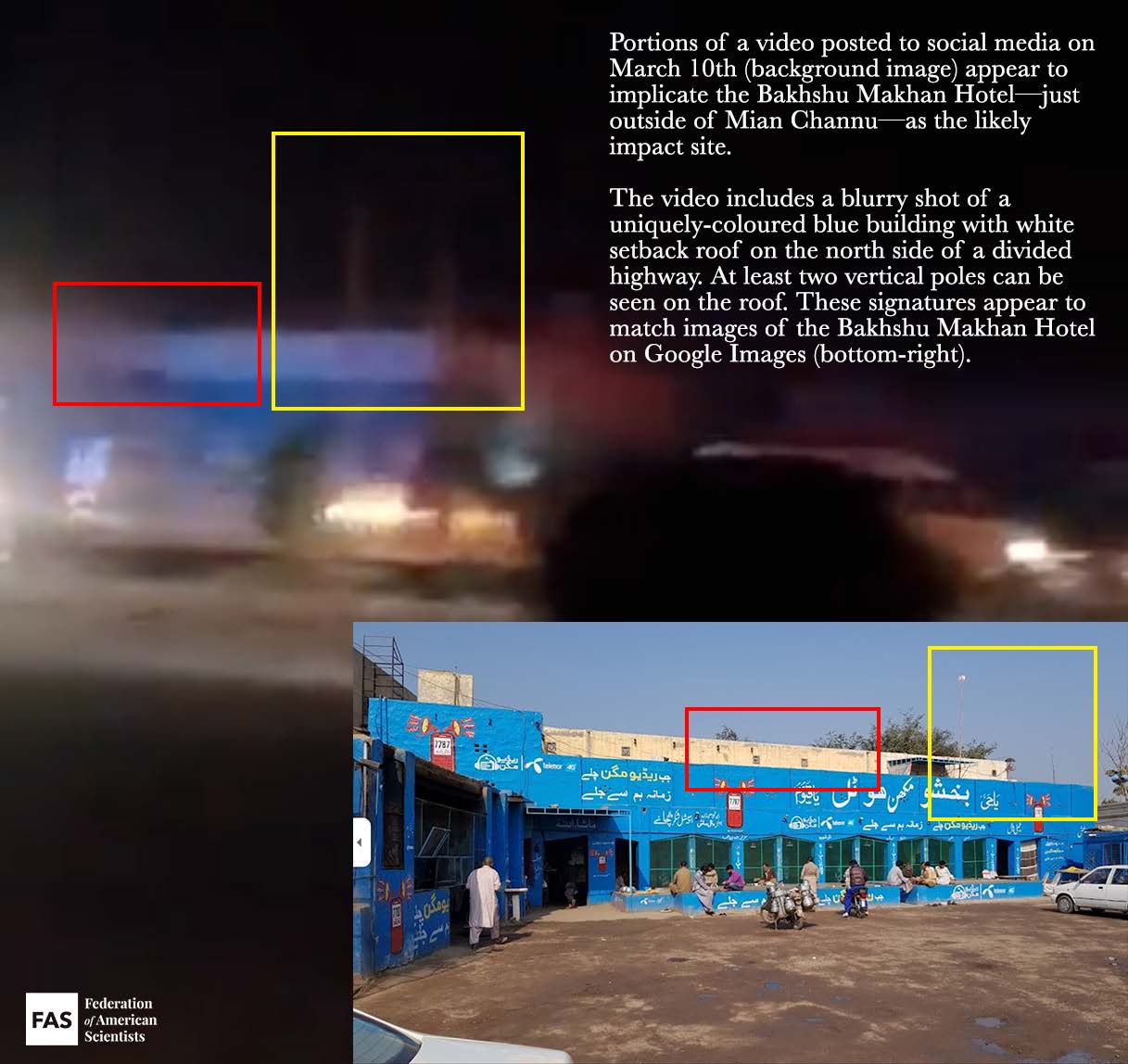
The video’s caption suggests that the object that crashed was an “army aviation aircraft drone;” however, Pakistani military officials subsequently reported that the object was an Indian missile. Neither Pakistan nor India has publicly confirmed what type of missile it was; however, in a March 10th press conference, Pakistani military officials stated that “we can so far deduce that it was a supersonic missile––an unknown missile––and it was launched from the ground, so it was a surface-to-surface missile.”
This statement, in addition to photos of the debris and other official details relating to range, speed, altitude, and flight time of the object, suggest that it was very likely a BrahMos cruise missile.
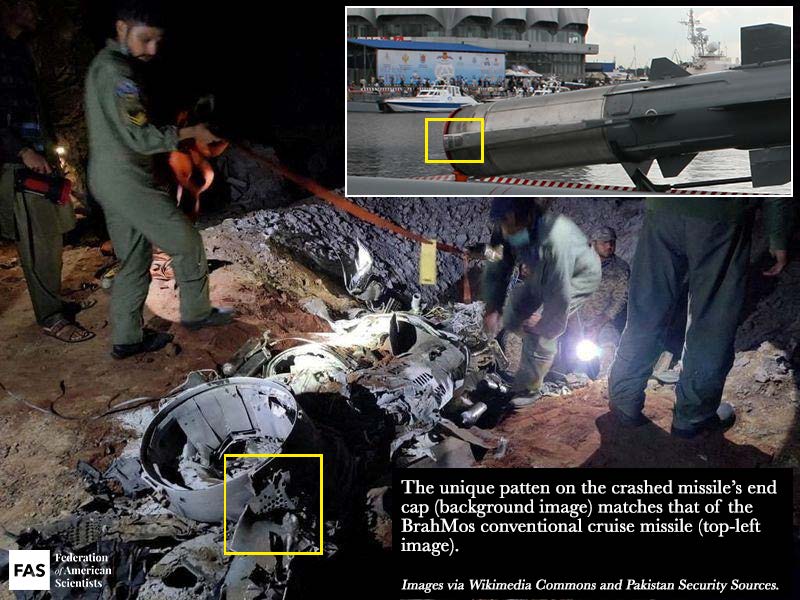
BrahMos is a ramjet-powered, supersonic cruise missile co-developed with Russia, that can be launched from land, sea, and air platforms and can travel at a speed of approximately March 2.8. The US National Air and Space Intelligence Centre (NASIC) suggested that an earlier version of BrahMos had a range of “less than 300” kilometers, but the Indian Ministry of Defence recently announced on 20 January 2022 that it had extended the BrahMos’ range, with defence sources saying that the missile could now travel over 500 kilometres. The reported speed of the “high-speed flying object,” as well as the distance traveled, matches the publicly-known capabilities of the BrahMos cruise missile.
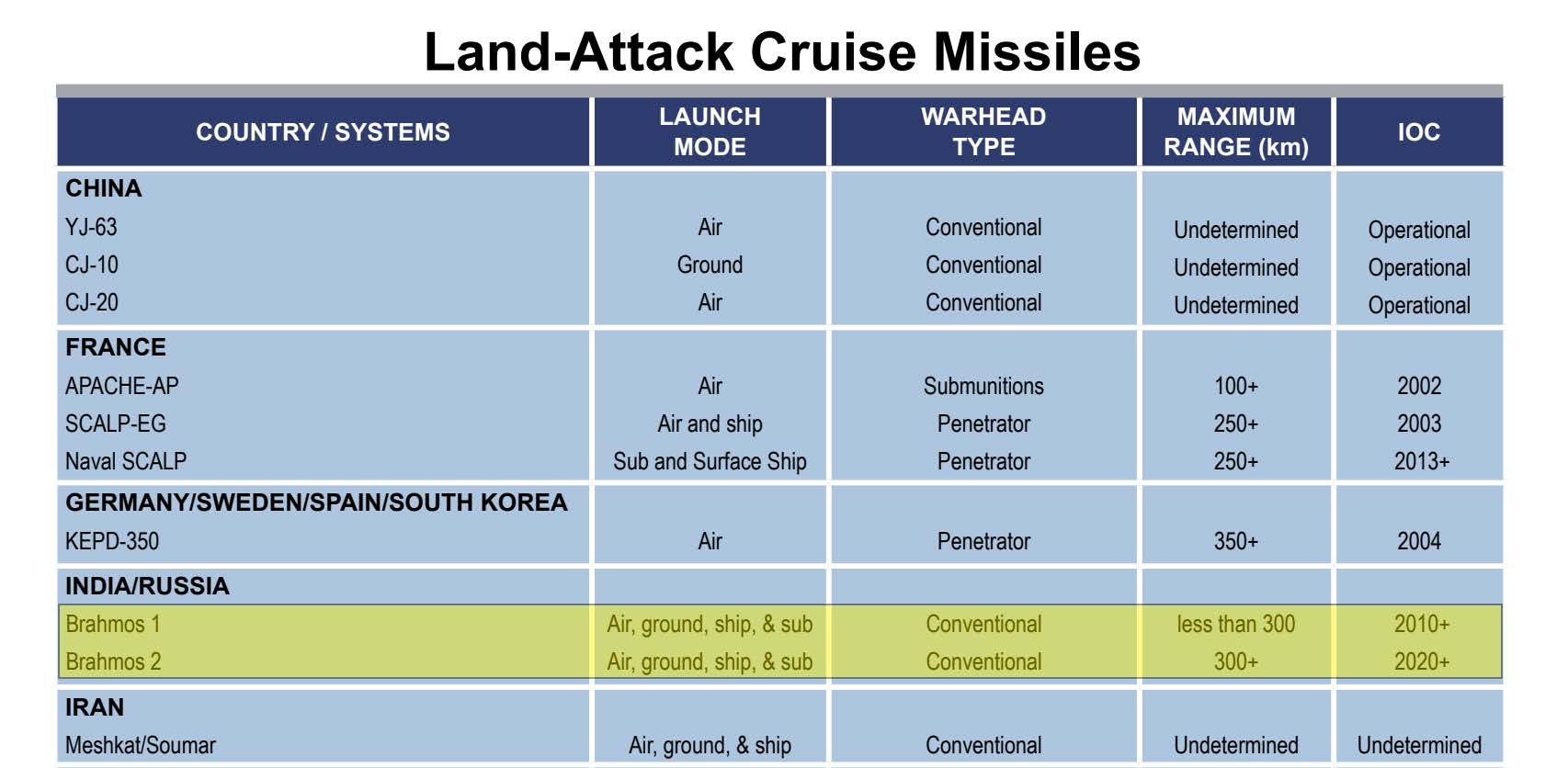
The National Air and Space Intelligence Center’s 2017 Ballistic and Cruise Missile report lists two versions of the BrahMos missile as “conventional.”
Although many Indian media outlets often describe the BrahMos as a nuclear or dual-capable system, NASIC lists it as “conventional,” and there is no public evidence to indicate that the missile can carry nuclear weapons.
India has launched a Court of Inquiry to determine how the incident occurred; however, the Indian government has otherwise remained tight-lipped on details. In the absence of official statements, small snippets have trickled out through Indian and Pakistani media sources––prompting several questions that still need answers.
How did the missile get “accidentally” launched?
According to the Times of India, an audit was being conducted by the Indian Air Force’s Directorate of Air Staff Inspection at the time of the launch. As part of that audit, or possibly as part of a separate exercise, it appears that target coordinates––including mid-flight waypoints––were fed into the missile’s guidance system. According to Indian defence sources, in order to launch the BrahMos, the missile’s mechanical and software safety locks would also have had to be bypassed and the launch codes would have had to be entered into the system.
The BrahMos does not appear to have a self-destruct mechanism. As a result, once the missile was launched, there was no way to abort.
Given that defence sources indicate that the missile “was certainly not meant to be launched,” it still remains unclear whether the launch was due to human or technical error. On March 11th, in its first public statement about the incident, the Indian government stated that “a technical malfunction led to the accidental firing of a missile.” However, since the formal convening of a Court of Inquiry, the government has since changed its rhetoric, with Indian officials stating that “the accidental firing took place because of human error. That’s what has emerged at this stage of the inquiry. There were possible lapses on the part of a Group Captain and a few others.” Tribute India reports that there are currently four individuals under investigation.
While this is certainly a plausible explanation for the incident, it is also worth noting that the Indian government would be financially incentivized to emphasize the human error narrative over a technical malfunction narrative. On January 28th, India concluded a $374.96 million deal with the Philippines to export the BrahMos––a deal which amounts to the country’s largest defence export contract. Additional BrahMos exports will be crucial for India to meet its ambitious defence export targets by 2025, and the negative publicity associated with a possible BrahMos technical malfunction could significantly hinder that goal.
Did Pakistan track the missile correctly?
In a press conference on March 10th, Pakistani military officials noted that Pakistan’s “actions, response, everything…it was perfect. We detected it on time, and we took care of it.” However, Indian military officials have publicly disputed Pakistan’s interpretation of the missile’s flight path. Pakistan announced on March 10th that the missile was picked up near Sirsa; however, Indian officials subsequently stated that the missile was launched from a location near Ambala Air Force Station, nearly 175 kilometers away. India’s explanation is likely to be more accurate, given that there is no known BrahMos base near Sirsa, but there is one near Ambala (h/t @tinfoil_globe). Indian defence sources have also suggested that the map of the missile’s perceived trajectory that the Pakistani military released on March 10th was incorrect.
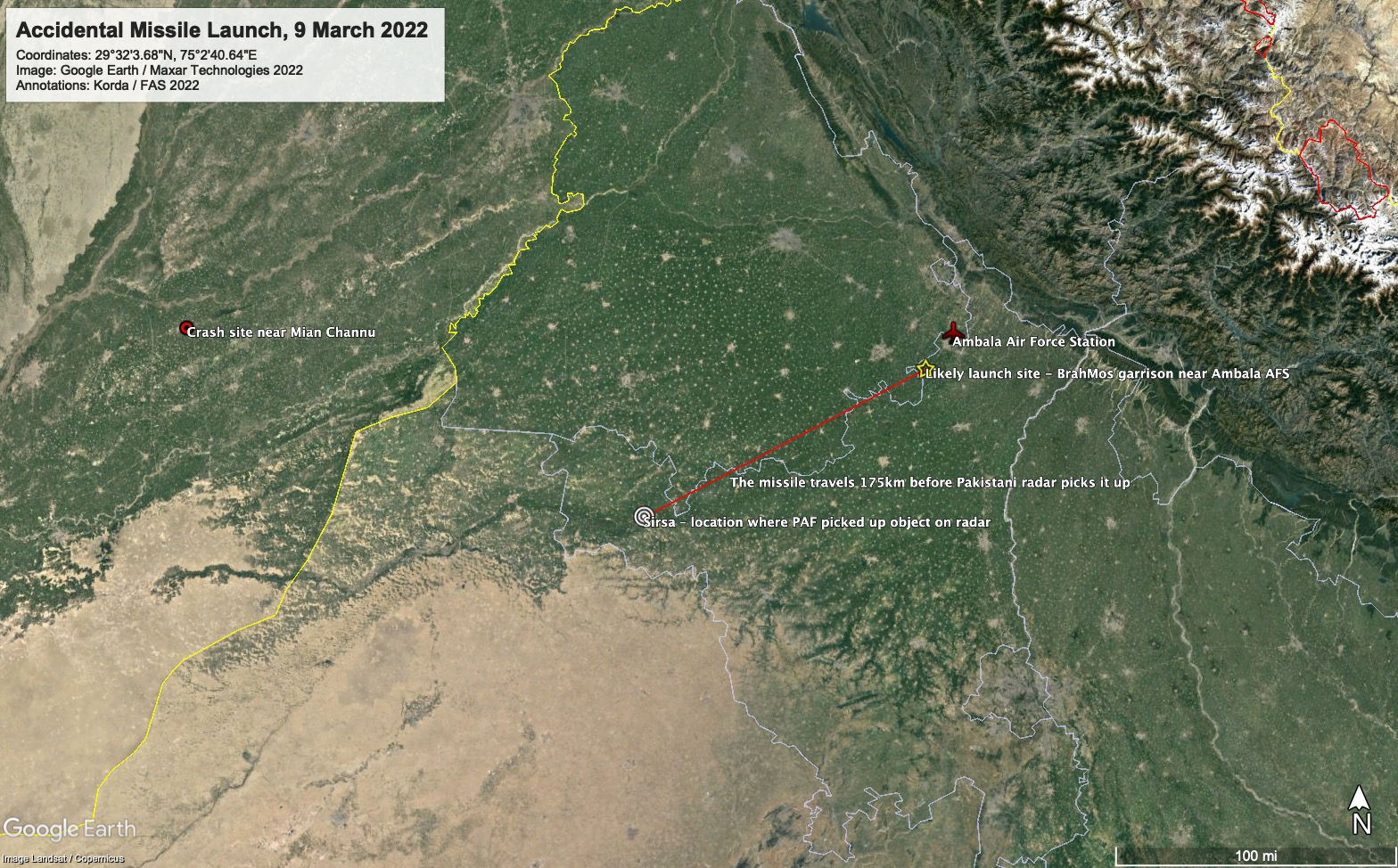
Annotated Google Earth image showing the 175 kilometer distance between the likely launch site and Pakistan’s radar pickup.
Furthermore, Pakistani officials announced on March 10th that the missile’s original destination was likely to be the Mahajan Field Firing Range in Rajasthan, before it suddenly turned and headed northwest into Pakistan. However, Indian defence sources have since suggested that the missile was not actually headed for the Mahajan Field Firing Range, but instead was “follow[ing] the trajectory that it would have in case of a conflict, but ‘certain factors’ played a role in ensuring that any pre-fed target was out of danger.” Given that the impact site was not near any critical military or political infrastructure, this could suggest that the cruise missile had its wartime mid-flight trajectory waypoints pre-loaded into the system, but its actual target had not yet been selected. If this is the case, then this targeting practice would be similar in nature to how some other nuclear-armed states target their missiles at the open ocean during peacetime––precisely in case of incidents like this one. Although the missile still landed on Pakistani territory, the fact that it did not hit any critical targets prevented the crisis from escalating. It is worth noting, however, that this would certainly not be the case if the missile had actually injured or killed anyone.
During the March 10th press conference, Pakistani officials noted that the Pakistan Air Force did not attempt to shoot down the missile because “the measures in place in times of war or in times of escalation are different [from those] in peace time.” However, India’s challenges to Pakistan’s narrative also raise significant questions about whether the Pakistan Air Force was able to accurately track the missile correctly. If not, then this raises the possibility of miscalculation or miscommunication, and crisis stability would be seriously eroded if a similar situation occurred during a time of heightened tensions.
Were any civilian aircraft put in danger?
In its public statements, Pakistan has emphasized that the accidental missile launch could have put civilian flights in danger, as India did not issue a Notice to Airmen (NOTAM) prior to launch. Governments typically issue NOTAMs in conjunction with missile tests, in order to inform civilian aircraft to avoid a particular patch of airspace during the launch window. Given that India did not issue one, a time-lapse video prepared by Flightradar24 showed that there were several civilian flights passing very close to the missile’s flight path at the time of launch. The video erroneously suggests that the missile traveled in a straight line from Ambala to Mian Channu, when it appears to have dog-legged in mid-flight; however, the video is still a useful resource to demonstrate how crowded the skies were at the time of the accident.
A screenshot of a video prepared by Flightradar24, showing that there were several civilian flights passing very close to the missile’s flight path at the time of launch.
Why was India’s response so poor?
Given the seriousness of the incident, India’s delayed response has been particularly striking. Immediately following the accidental launch, India could have alerted Pakistan using its high-level military hotlines; however, Pakistani officials stated that it did not do so. Additionally, India waited two days after the incident before issuing a short public statement.
India’s poor response to this unprecedented incident has serious implications for crisis stability between the two countries. According to DNA India, in the absence of clarification from India, Pakistan Air Force’s Air Defence Operations Centre immediately suspended all military and civilian aircraft for nearly six hours, and reportedly placed frontline bases and strike aircraft on high alert. Defence sources stated that these bases remained on alert until 13:00 PKT on March 14th. Pakistani officials appeared to confirm this, noting that “whatever procedures were to start, whatever tactical actions had to be taken, they were taken.”
We were very, very lucky
Thankfully, this incident took place during a period of relative peacetime between the two nuclear-armed countries. However, in recent years India and Pakistan have openly engaged in conventional warfare in the context of border skirmishes. In one instance, Pakistani military officials even activated the National Command Authority––the mechanism that directs the country’s nuclear arsenal––as a signal to India. At the time, the spokesperson of the Pakistan Armed Forces not-so-subtly told the media, “I hope you know what the NCA means and what it constitutes.”
If this same accidental launch had taken place during the 2019 Balakot crisis, or a similar incident, India’s actions were woefully deficient and could have propelled the crisis into a very dangerous phase.
Furthermore, as we have written previously, in recent years India’s rocket forces have increasingly worked to “canisterize” their missiles by storing them inside sealed, climate-controlled tubes. In this configuration, the warhead can be permanently mated with the missile instead of having to be installed prior to launch, which would significantly reduce the amount of time needed to launch nuclear weapons in a crisis.
This is a new feature of India’s Strategic Forces Command’s increased emphasis on readiness. In recent years, former senior civilian and military officials have reportedly suggested in interviews that “some portion of India’s nuclear force, particularly those weapons and capabilities designed for use against Pakistan, are now kept at a high state of readiness, capable of being operationalized and released within seconds or minutes in a crisis—not hours, as had been assumed.”
This would likely cause Pakistan to increase the readiness of its missiles as well and shorten its launch procedures––steps that could increase crisis instability and potentially raise the likelihood of nuclear use in a regional crisis. As Vipin Narang and Christopher Clary noted in a 2019 article for International Security, this development “enables India to possibly release a full counterforce strike with few indications to Pakistan that it was coming (a necessary precondition for success). If Pakistan believed that India had a ‘comprehensive first strike’ strategy and with no indication of when a strike was coming, crisis instability would be amplified significantly.”
India’s recent missile accident––and the deficient political and military responses from both parties––suggests that regional crisis instability is less stable than previously assumed. To that end, this crisis should provide an opportunity for both India and Pakistan to collaboratively review their communications procedures, in order to ensure that any future accidents prompt diplomatic responses, rather than military ones.
Background Information:
- “Indian Nuclear Forces, 2020,” FAS Nuclear Notebook, Bulletin of the Atomic Scientists, July/August 2020.
- “Pakistan Nuclear Weapons, 2021,” FAS Nuclear Notebook, Bulletin of the Atomic Scientists, Sept/Oct 2021.
- “India’s Nuclear Arsenal Takes A Big Step Forward,” FAS Strategic Security Blog, Dec 2021.
- Status of World Nuclear Forces, Federation of American Scientists
This article was made possible with generous support from the John D. and Catherine T. MacArthur Foundation, the New-Land Foundation, the Prospect Hill Foundation, and the Ploughshares Fund. The statements made and views expressed are solely the responsibility of the author.
*[Note: This type of missile accident has apparently happened before; on 11 September 1986, a Soviet missile flew more than 1,500 off-course and landed in China. Thank you to the excellent Stephen Schwartz for the historical reference.]
Categories: Arms Control, ballistic missiles, Deterrence, Disarmament, India, Nuclear Weapons, Pakistan
India’s Nuclear Arsenal Takes A Big Step Forward
On 18 December 2021, India tested its new Agni-P medium-range ballistic missile from its Integrated Test Range on Abdul Kalam Island. This was the second test of the missile, the first test having been conducted in June 2021.
Our friends at Planet Labs PBC managed to capture an image of the Agni-P launcher sitting on the launch pad the day before the test took place.
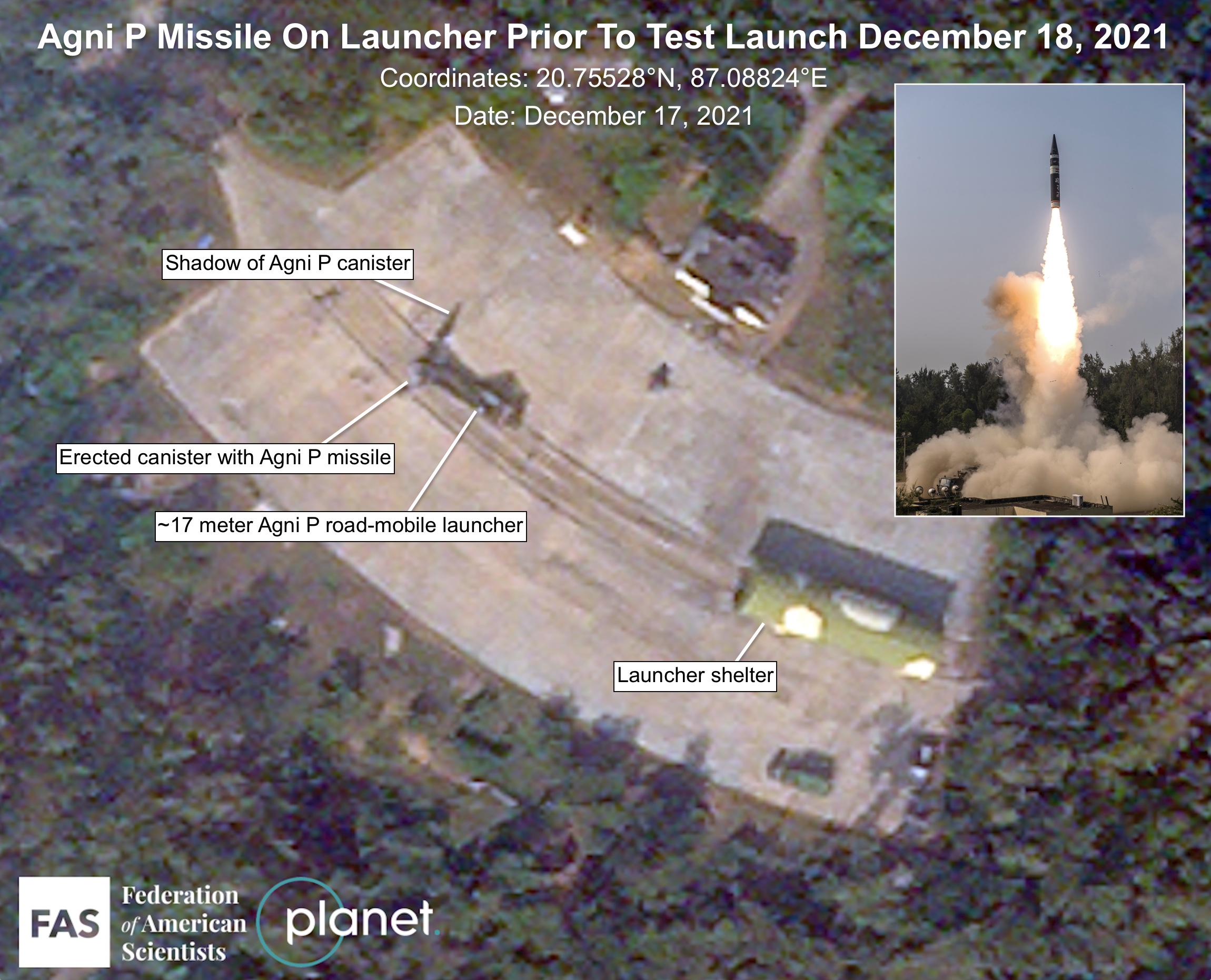
Following both launches of the Agni-P, the Indian Government referred to the missile as a “new generation” nuclear-capable ballistic missile. Back in 2016, when the Defence Research and Development Organisation (DRDO) first announced the development of the Agni-P (which was called the Agni-1P at the time), a senior DRDO official explained why this missile was so special:
“As our ballistic missiles grew in range, our technology grew in sophistication. Now the early, short-range missiles, which incorporate older technologies, will be replaced by missiles with more advanced technologies. Call it backward integration of technology.”
The Agni-P is India’s first shorter-range missile to incorporate technologies now found in the newer Agni-IV and -V ballistic missiles, including more advanced rocket motors, propellants, avionics, and navigation systems.
Most notably, the Agni-P also incorporates a new feature seen on India’s new Agni-V intermediate-range ballistic missiles that has the potential to impact strategic stability: canisterization. And the launcher used in the Agni-P launch appears to have increased mobility. There are also unconfirmed rumors that the Agni-P and Agni-V might have the capability to launch multiple warheads.
Canisterization
“Canisterizing” refers to storing missiles inside a sealed, climate-controlled tube to protect them from the outside elements during transportation. In this configuration, the warhead can be permanently mated with the missile instead of having to be installed prior to launch, which would significantly reduce the amount of time needed to launch nuclear weapons in a crisis. This is a new feature of India’s Strategic Forces Command’s increased emphasis on readiness. In recent years, former senior civilian and military officials have reportedly suggested in interviews that “some portion of India’s nuclear force, particularly those weapons and capabilities designed for use against Pakistan, are now kept at a high state of readiness, capable of being operationalized and released within seconds or minutes in a crisis—not hours, as had been assumed.”
If Indian warheads are increasingly mated to their delivery systems, then it would be harder for an adversary to detect when a crisis is about to rise to the nuclear threshold. With separated warheads and delivery systems, the signals involved with mating the two would be more visible in a crisis, and the process itself would take longer. But widespread canisterization with fully armed missiles would shorten warning time. This would likely cause Pakistan to increase the readiness of its missiles as well and shorten its launch procedures––steps that could increase crisis instability and potentially raise the likelihood of nuclear use in a regional crisis. As Vipin Narang and Christopher Clary noted in a 2019 article for International Security, this development “enables India to possibly release a full counterforce strike with few indications to Pakistan that it was coming (a necessary precondition for success). If Pakistan believed that India had a ‘comprehensive first strike’ strategy and with no indication of when a strike was coming, crisis instability would be amplified significantly.”
For years, it was evident that India’s new Agni-V intermediate-range missile (the Indian Ministry of Defense says Agni-V has a range of up to 5,000 kilometers; the US military says the range is over 5,000 kilometers but not ICBM range) would be canisterized; however, the introduction of the shorter-range, canisterized Agni-P suggests that India ultimately intends to incorporate canisterization technology across its suite of land-based nuclear delivery systems, encompassing both shorter- and longer-range missiles. While Agni-V is a new addition to India’s arsenal, Arni-P might be intended––once it becomes operational––to replace India’s older Agni-I and Agni-II systems.
MIRV technology
It appears that India is also developing technology to potentially deploy multiple warheads on each missile. There is still uncertainty about how advanced this technology is and whether it would enable independent targeting of each warhead (using multiple independently-targetable reentry vehicles, or MIRVs) or simply multiple payloads against the same target.
The Agni-P test in June 2021 was rumored to have used two maneuverable decoys to simulate a MIRVed payload, with unnamed Indian defense sources suggesting that a functional MIRV capability will take another two years to develop and flight-test. The Indian MOD press release did not mention payloads. It is unclear whether the December 2021 test utilized decoys in a similar manner.
In 2013, the director-general of DRDO noted in an interview that “Our design activity on the development and production of MIRV is at an advanced stage today. We are designing the MIRVs, we are integrating [them] with Agni IV and Agni V missiles.” In October 2021, the Indian Strategic Forces Command conducted its first user trial of the Agni-V in full operational configuration, which was rumored to have tested MIRV technology. The MOD press release did not mention MIRVs.
If India succeeds in developing an operational MIRV capability for its ballistic missiles, it would be able to strike more targets with fewer missiles, thus potentially exacerbating crisis instability with Pakistan. If either country believed that India could potentially conduct a decapitating or significant first strike against Pakistan, a serious crisis could potentially go nuclear with little advance warning. Indian missiles with MIRVs would become more important targets for an adversary to destroy before they could be launched to reduce the damage India could inflict. Additionally, India’s MIRVs might prompt Indian decision-makers to try and preemptively disarm Pakistan in a crisis.
India’s other nuclear adversary, China, has already developed MIRV capability for some of its long-range missiles and is significantly increasing its nuclear arsenal, which might be a factor in India’s pursuit of MIRV technology. A MIRV race between the two countries would have significant implications for nuclear force levels and regional stability. For India, MIRV capability would allow it to more rapidly increase its nuclear stockpile in the future, if it so decided––especially if its plutonium production capability can make use of the unsafeguarded breeder reactors that are currently under construction.
Implications for India’s nuclear policy
India has long adhered to a nuclear no-first-use (NFU) policy and in 2020 India officially stated that there has been no change in its NFU policy. Moreover, the Agni-V test launch in October 2021 was accompanied by a reaffirmation of a “’credible minimum deterrence’ that underpins the commitment to ‘No First Use’.”
At the same time, however, the pledge to NFU has been caveated, watered-down, and called into question by government statements and recent scholarship. The increased readiness and pursuit of MIRV capability for India’s strategic forces could further complicate India’s adherence to its NFU policy and could potentially cause India’s nuclear adversaries to doubt its NFU policy altogether.
Given that Indian security forces have repeatedly clashed with both Pakistani and Chinese troops during recent border disputes, potentially destabilizing developments in India’s nuclear arsenal should concern all those who want to keep regional tensions below boiling point.
Background Information:
- “Indian Nuclear Forces, 2020,” FAS Nuclear Notebook, Bulletin of the Atomic Scientists, July/August 2020.
- Status of World Nuclear Forces, Federation of American Scientists
This article was made possible by generous support from the John D. and Catherine T. MacArthur Foundation, the New Land Foundation, the Prospect Hill Foundation, and the Ploughshares Fund. The statements made and views expressed are solely the responsibility of the authors.
New NASIC Report Appears Watered Down And Out Of Date
The US Air Force National Air and Space Intelligence Center (NASIC) has published a new version of its widely referenced Ballistic and Cruise Missile Threat report.
The agency normally puts out an updated version of the report every four years. The previous version dates from 2017.
The 2021 report (dated 2020) provides information on developments in many countries but is clearly focused on China, Iran, North Korea, and Russia. Especially the North Korean data is updated because of the significant developments since 2017.
The most interesting new information in the updated report is probably that the new Chinese JL-3 sea-launched ballistic missile (SLBM) is capable of carrying multiple warheads.
Overall, however, the new report may be equally interesting because of what it does not include. There are a number of cases where the report is scaled back compared with previous versions. And throughout the report, much of the data clearly hasn’t been updated since 2018. In some places it is even inconsistent and self-contradicting.
The most significant data reduction is in the cruise missile section where the report no longer lists countries other than Russia, China, and Iran. This is a significant change from previous reports that listed a wide range of other countries, including India and Pakistan and many others that have important cruise missile programs in development. The omission is curious because the report in all ballistic missile categories includes other countries.

Cruise missile data is significantly reduced in the new NASIC report compared with the previous version from 2017. Click on image to view full size.
Other examples of reduced data include the overview of ballistic missile launches, which for some reason does not show data for 2019 and 2020. Nor is it clear from the table which countries are included.
Also, in some descriptions of missile program developments the report appears to be out of date and not update on recent developments. This includes the Russian SS-X-28 (RS-26 Rubezh) shorter-range ICBM, which the report portrays as an active program but only presents data for 2018. Likewise, the report does not mention the two additional boats being added to the Chinese SSBN fleet. Moreover, the new section with air-launched ballistic missiles only includes Russia but leaves out Chinese developments and only appears to include data up through early 2018.
Whether these omissions reflect changes in classification rules, chaos is the Intelligence Community under the Trump administration, or simply oversight is unknown.
Below follows highlights of some of the main nuclear issues in the new report.
Russian Nuclear Forces
Information about Russian ballistic and cruise missile programs dominate the report, but less so than in previous versions. NASIC says Russia currently has approximately 1,400 nuclear warheads deployed on ICBMs and SLBMs, a reduction from the “over 1,500” reported in 2017. The new number is well known from the release of New START data and is very close to the 1,420 warheads we estimated in our Russian Nuclear Notebook last year.
NASIC repeats the projection from 2017, that “the number of missiles in the Russian ICBM force will continue to decrease because of arms control agreements, aging missiles, and resource constraints….”
The statement that “Russia retains over 1,000 nuclear warheads on ICBMs” is curious, however, because would imply the SLBM force is loaded with fewer warheads than normally assumed. The warhead loading attributed to the SS-N-32 (Bulava) is 6, the number declared by Russia under the START treaty, and less than the 10 warheads that is often claimed by unofficial sources.
The new version describes continued development of the SS-28 (RS-26 (Rubezh) shorter-range ICBM suspected by some to actually be an IRBM. But the report only lists development activities up through 2018 and nothing since. The system is widely thought to have been mothballed due to budget constraints.
The cruise missile section attributes nuclear capability – or possible nuclear capability – to most of the Russian missiles listed. Six systems are positively identified as nuclear, including the Kh-102, which was not listed in the 2017 report. Two of the nuclear systems are dual-capable, including the 9M729 (SSC-8) missile the US said violated the now-abandoned INF treaty, while 3 missiles are listed as “Conventional, Nuclear Possible.” That includes the 9M728 (R-500) cruise missile (SSC-7) launched by the Iskander system, the 3M-14 (Kalibr) cruise missile (SS-N-30), and the 3M-55 (Yakhont, P-800) cruise missile (SS-N-26).
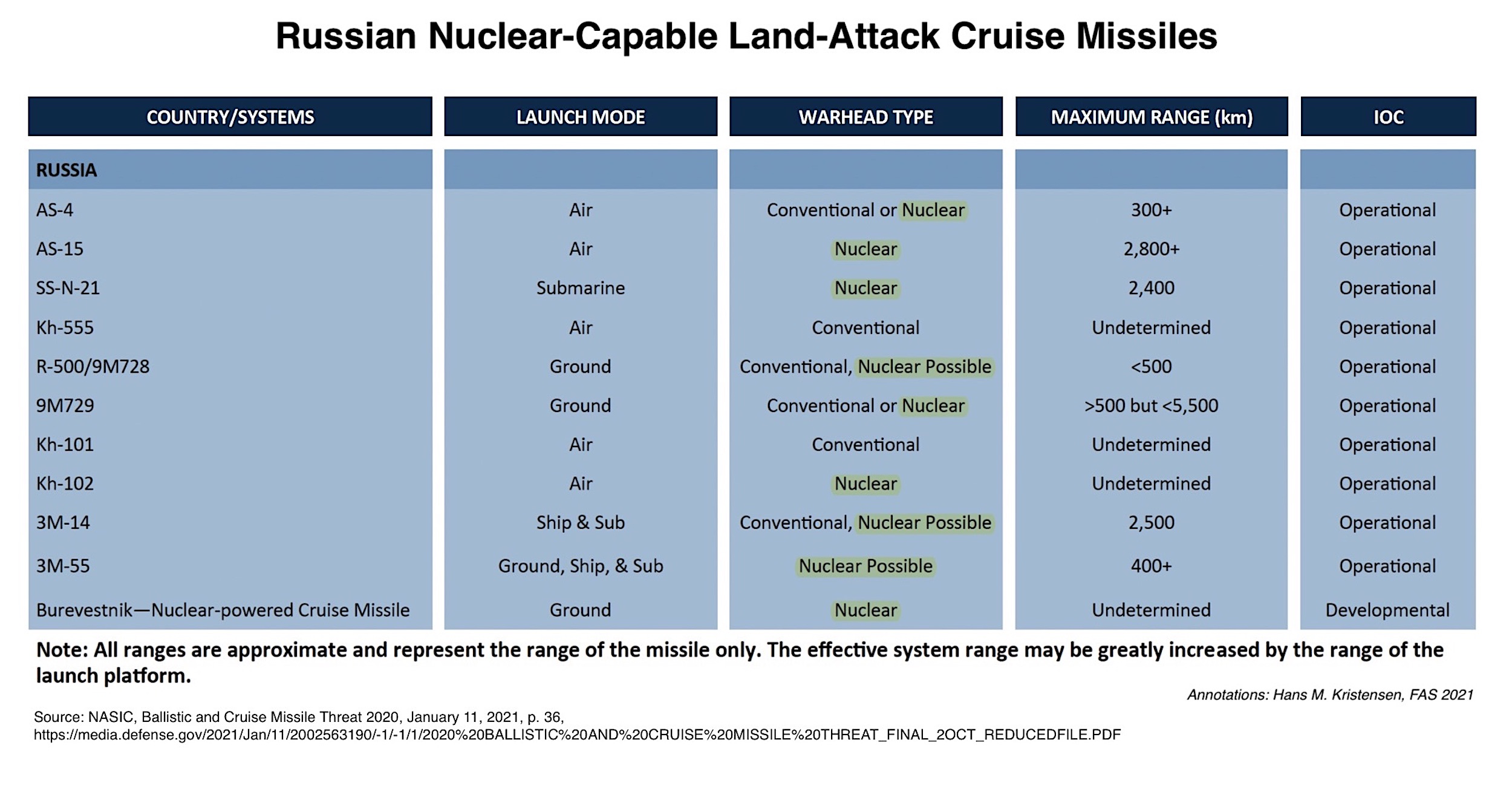
NASIC attributes nuclear capability to nine Russian land-attack cruise missiles, three of them “possible.” Click on image to view full size.
The designation of “nuclear possible” for the SS-N-30 (3M-14, often called the Kalibr even though Kalibr is strictly speaking the name of the launcher system) is curious because the Russian government has clearly stated that the missile is nuclear-capable.
Chinese Nuclear Forces
The biggest news in the China section of the NASIC report is that the new JL-3 SLBM that will arm the next-generation Type 096 SSBN will be capable of delivering “multiple” warheads and have a range of more than 10,000 kilometers. That is a significant increase in capability compared with the JL-2 SLBM currently deployed on the Jin-class SSBNs and is likely part of the reason for the projection that China’s nuclear stockpile might double over the next decade.

NASIC reports that China’s next-generation JL-3 SLBM will be capable of carrying “multiple” warheads. Click on image to view full size.
Despite this increased range, however, a Type 096 operating from the current SSBN base in the South China Sea would not be able to strike targets in the continental United States. To be able to reach targets in the continental United States, an SSBN would have to launch its missile from the Bohai Sea. That would bring almost one-third of the continental United States within range. To target Washington, DC, however, a Type 096 SSBN would still have to deploy deep into the Pacific.
The new DF-41 (CSS-20) has lost its “-X-“ designation (CSS-X-20), which indicates that NASIC considers the missile has finished development is now being deployed. A total of 16+ launchers are listed, probably based on the number attending the 2019 parade in Beijing and the number seen operating in the Jilantai training area.
The number of DF-31A and DF-31AG launchers is very low, 15+ and 16+ respectively, which is strange given the number of bases observed with the launchers. Of course, “+” can mean anything and we estimate the number of launchers is probably twice that number. Also interesting is that the DF-31AG is listed as “UNK” (unknown) for warheads per missile. The DF-31A is listed with one warhead, which suggests that the AG version potentially could have a different payload. Nowhere else is the AG payload listed as different or even multiple warheads.
The NASIC report projection for the increase in Chinese nuclear ICBM warheads that can reach the United States is inconsistent and self-contradicting. In one section (p. 3) the report predicts “the number of Chinese ICBM nuclear warheads capable of reaching the United States potentially expanding to well over 200 within the next 5 years.” But in another section (p. 27), the report states that the “number of warheads on Chinese ICBMs capable of threatening the United States is expected to grow to well over 100 in the next 5 years.” The projection of “well over 100” was also listed in the 2017 report, and the “well over 200” projection matches the projection made in the DOD annual report on Chinese military developments. So the authors of the NASIC might simply have forgotten to update the text.
On Chinese shorter-range ballistic missiles, the NASIC report only mentions DF-21A (CSS-5 Mod 2) as nuclear, but not the CSS-5 Mod 6 version. The Mod 6 version (potentially called DF-21E) was first mentioned in the 2016 DOD report on Chinese military developments and has been included since.
Newer missiles finally get designations: The dual-capable DF-26 is called the CSS-18, and the conventional (possibly) DF-17 is called the CSS-22. NASIC continues to list the DF-26 range as less (3,000+ km) than the annual DOD China report (4,000 km).
An in case anyone was tempted, no, none of China’s cruise missiles are listed as nuclear-capable.
Pakistani Nuclear Forces
The report provides no new information about Pakistani nuclear-capable ballistic missiles. As with several other sections in the report, the information does not appear to have been updated much beyond 2018, if at all. As such, status information should be read with caution.
The Shaheen-III MRBM is still not deployed, nor is the Ababeel MRBM that NASIC describes as a “MIRV version.” It has only been flight-tested once.
The tactical nuclear-capable NASR is listed with a range of 60 km, the same as in 2017, even though the Pakistani government has since claimed the range has been extended to 70 km.
Because the new NASIC report no longer includes data on Pakistan’s cruise missiles, neither the Babur nor the RAAD programs are described. Nor is any information provided about the efforts by the Pakistani navy to develop a submarine-launched nuclear-capable cruise missile.
Indian Nuclear Forces
Similar to other sections of the report, the data on Indian programs are tainted by the fact that some information does not appear to have been updated since 2018, and that the cruise missile section does not include India at all.
According to the report, Agni II and Agni III MRBMs are still deployed in very low numbers, fewer than 10 launchers, the same number reported in 2017. That number implies only a single brigade of each missile. But, again, it is not clear this information has actually been updated.
Nor are the Agni IV or the Agni V listed as deployed yet.
North Korean Forces
The North Korean sections are main interesting because of the inclusion of data on several systems test-launched since the previous report in 2017. This contrasts several other data set in the report, which do not appear to have been updated past 2018. But since the North Korean long-range tests occurred in 2017, this may explain why they are included.
NASIC provides official (unclassified) range estimates for these missiles:
The Hwasong-12 IRBM range has been increased from 3,000+ km in 2017 to 4,500+ km in the new report.
On the ICBMs, the Taepo Dong 2 no longer has a range estimate. The Hwasong-13 and Hwasong-14 range estimates have been raised from the generic 5,500+ km in the 2017 report to 12,000 km and 10,000+ km, respectively, in the new report, and the new Hwasong-15 has been added with a range estimate of 12,000+ km. The warhead loading estimates for the Hwasong-14 and Hwasong-15 are “unknown” and none of the ICBMs are listed as deployed.
On submarine-launched missiles, the NASIC report lists two: the Puguksong-1 and Pukguksong-3. Both have range estimates of 1,000+ km and the warhead estimate for the Pukguksong-3 is unknown (“UNK”). Neither is deployed. The new Pukguksong-4 paraded in October 2020 is not listed, not is the newest Pukguksong-5 displayed in early 2021 mentioned.
Additional background information:
• Russian nuclear forces, 2020
Environmental Assessment Reveals New Details About the Air Force’s ICBM Replacement Plan
Any time a US federal agency proposes a major action that “has the potential to cause significant effects on the natural or human environment,” they must complete an Environmental Impact Statement, or EIS. An EIS typically addresses potential disruptions to water supplies, transportation, socioeconomics, geology, air quality, and other factors in great detail––meaning that one can usually learn a lot about the scale and scope of a federal program by examining its Environmental Impact Statement.
What does all this have to do with nuclear weapons, you ask?
Well, given that the Air Force’s current plan to modernize its intercontinental ballistic missile force involves upgrading hundreds of underground and aboveground facilities, it appears that these actions have been deemed sufficiently “disruptive” to trigger the production of an EIS.
To that end, the Air Force recently issued a Notice of Intent to begin the EIS process for its Ground-Based Strategic Deterrent (GBSD) program––the official name of the ICBM replacement program. Usually, this notice is coupled with the announcement of open public hearings, where locals can register questions or complaints with the scope of the program. These hearings can be influential; in the early 1980s, tremendous public opposition during the EIS hearings in Nevada and Utah ultimately contributed to the cancellation of the mobile MX missile concept. Unfortunately, in-person EIS hearings for the GBSD have been cancelled due to the ongoing Covid-19 pandemic; however, they’ve been replaced with something that might be even better.
The Air Force has substituted its in-person meetings for an uncharacteristically helpful and well-designed website––gbsdeis.com––where people can go to submit comments for EIS consideration (before November 13th!). But aside from the website being just a place for civic engagement and cute animal photos, it is also a wonderful repository for juicy––and sometimes new––details about the GBSD program itself.
The website includes detailed overviews of the GBSD-related work that will take place at the three deployment bases––F.E. Warren (located in Wyoming, but responsible for silos in Wyoming, Colorado, and Nebraska), Malmstrom (Montana), and Minot (North Dakota)––plus Hill Air Force Base in Utah (where maintenance and sustainment operations will take place), the Utah Test and Training Range (where missile storage, decommissioning, and disposal activities will take place), Camp Navajo in Arizona (where rocket boosters and motors will be stored), and Camp Guernsey in Wyoming (where additional training operations will take place).
Taking a closer look at these overviews offers some expanded details about where, when, and for how long GBSD-related construction will be taking place at each location.
For example, previous reporting seemed to indicate that all 450 Minuteman Launch Facilities (which contain the silos themselves) and “up to 45” Missile Alert Facilities (each of which consists of a buried and hardened Launch Control Center and associated above- or below-ground support buildings) would need to be upgraded to accommodate the GBSD. However, the GBSD EIS documents now seem to indicate that while all 450 Launch Facilities will be upgraded as expected, only eight of the 15 Missile Alert Facilities (MAF) per missile field would be “made like new,” while the remainder would be “dismantled and the real property would be disposed of.”
Currently, each Missile Alert Facility is responsible for a group of 10 Launch Facilities; however, the decision to only upgrade eight MAFs per wing––while dismantling the rest––could indicate that each MAF could be responsible for up to 18 or 19 separate Launch Facilities once GBSD becomes operational. If this is true, then this near-doubling of each MAF’s responsibilities could have implications for the future vulnerability of the ICBM force’s command and control systems.
The GBSD EIS website also offers a prospective construction timeline for these proposed upgrades. The website notes that it will take seven months to modernize each Launch Facility, and 12 months to modernize each Missile Alert Facility. Once construction begins, which could be as early as 2023, the Air Force has a very tight schedule in order to fully deploy the GBSD by 2036: they have to finish converting one Launch Facility per week for nine years. It is expected that construction and deployment will begin at F.E. Warren between 2023 and 2031, followed by Malmstrom between 2025 and 2033, and finally Minot between 2027 and 2036.
Although it is still unclear exactly what the new Missile Alert Facilities and Launch Facilities will look like, the EIS documents helpfully offer some glimpses of the GBSD-related construction that will take place at each of the three Air Force bases over the coming years.
In addition to the temporary workforce housing camps and construction staging areas that will be established for each missile wing, each base is expected to receive several new training, storage, and maintenance facilities. With a single exception––the construction of a new reentry system and reentry vehicle maintenance facility at Minot––all of the new facilities will be built outside of the existing Weapons Storage Areas, likely because these areas are expected to be replaced as well. As we reported in September, construction has already begun at F.E. Warren on a new underground Weapons Generation Facility to replace the existing Weapons Storage Area, and it is expected that similar upgrades are planned for the other ICBM bases.
Finally, the EIS documents also provide an overview of how and where Minuteman III disposal activities will take place. Upon removal from their silos, the Minutemen IIIs will be transported to their respective hosting bases––F.E. Warren, Malmstrom, or Minot––for temporary storage. They will then be transported to Hill Air Force Base, the Utah Test and Training Range (UTTR), or Camp Najavo, in Arizona. It is expected that the majority of the rocket motors will be stored at either Hill AFB or UTTR until their eventual destruction at UTTR, while non-motor components will be demilitarized and disposed of at Hill AFB. To that end, five new storage igloos and 11 new storage igloos will be constructed at Hill AFB and UTTR, respectively. If any rocket motors are stored at Camp Navajo, they will utilize existing storage facilities.
After the completion of public scoping on November 13th (during which anyone can submit comments to the Air Force via Google Form), the next public milestone for the GBSD’s EIS process will occur in spring 2022, when the Air Force will solicit public comments for their Draft EIS. When that draft is released, we should learn even more about the GBSD program, and particularly about how it impacts––and is impacted by––the surrounding environment. These particular aspects of the program are growing in significance, as it is becoming increasingly clear that the US nuclear deterrent––and particularly the ICBM fleet deployed across the Midwest––is uniquely vulnerable to climate catastrophe. Given that the GBSD program is expected to cost nearly $264 billion through 2075, Congress should reconsider whether it is an appropriate use of public funds to recapitalize on elements of the US nuclear arsenal that could ultimately be rendered ineffective by climate change.
Additional background information:
- United States nuclear forces, 2020
-
Construction of New Underground Nuclear Warhead Facility At Warren AFB
This publication was made possible by generous contributions from the Carnegie Corporation of New York, the John D. and Catherine T. MacArthur Foundation, the New Land Foundation, the Ploughshares Fund, and the Prospect Hill Foundation. The statements made and views expressed are solely the responsibility of the author.
Image sources: Air Force Global Strike Command. 2020. “Environmental Impact Statement for the Ground-Based Strategic Deterrent Deployment and Minuteman III Decommissioning and Disposal: Public Scoping Materials.”
A Rare Look Inside a Russian ICBM Base
It’s relatively easy to observe Russian missile bases from above. It’s much harder to do it from inside.
But in September, the Russian Ministry of Defense released a rare video of a command exercise which features mobile SS-27 Mod 2 “Yars-S” ICBMs driving around their base near Novosibirsk.
The base itself, which is likely to be the temporary home of the 382nd Guards Missile Regiment, has a relatively strange layout, which makes it significantly easier to identify. Unlike other Yars bases in the 39th Guards Missile Division (which houses the 382nd Regiment)––or even across the region––this base does not have any vehicle garages. Instead, the Yars launchers and support vehicles are simply parked out in the open, usually under camouflage (although they occasionally mix up their camouflage, weirdly replacing the forest green with snowy white well before any snow actually touches the ground!).
The September video shows Russian troops uncovering their ICBMs, taking them out for a spin, and eventually tucking them back in under camouflage blankets.
This regiment––along with the other two Novosibirsk bases associated with the 39th Guards Missile Division––recently completed its long-awaited conversion to Yars ICBMs from its older SS-25 Topol ICBMs. These new missiles are clearly visible in both satellite imagery and in the Ministry of Defense video.
During its conversion, the regiment was moved from its previous base (55°19’2.72”N, 83°10’6.70”E) to this temporary location, while the old base was dismantled in preparation for a substantial upgrade to build new missile shelters for the Yars ICBMs, as well as service and administrative buildings. Construction stalled for several years, possibly because of budget cuts, but has recently picked up again. Once completed, the 382nd Guards Missile Regiment presumably will be relocated back to its old base.
As we write in the Nuclear Notebook, Russia continues to retire its SS-25s at a rate of one or two regiments (nine to 18 missiles) each year, replacing them with newer Yars ICBMs. It is unclear how many SS-25s remain in the active missile force; however, we estimate that it is approximately 54. The remaining two SS-25 equipped divisions will start their upgrades to Yars in 2020, with the SS-25s expected to be fully retired in 2021-2022, according to the commander of Russia’s Strategic Rocket Forces.
Read more about Russia’s nuclear forces in the 2019 Russian Nuclear Notebook, which is always freely-accessible via the Bulletin of the Atomic Scientists.
Chinese DF-26 Missile Launchers Deploy To New Missile Training Area
[Updated Jan 31, 2019] Earlier this month, the Chinese government outlet Global Times published a report that a People’s Liberation Army Rocket Force (PLARF) unit with the new DF-26 intermediate-range ballistic missile had carried out an exercise in the “Northwest China’s plateau and desert areas.” The article made vague references to a program previously aired on China’s CCTV-7 that showed a column of DF-26 launchers and support vehicles driving on highways, desert roads, and through mountain streams.
As it turns out, the exercise may have been west of Beijing, but the actual location is in upper Central China. Several researchers (for example Sean O’Connor) have been attempting to learn more about the unit. By combining scenes from the CCTV-7 program with various satellite imagery sources, I was able to geolocate the DF-26s to the S218 highway (39.702137º, 105.731469º) outside the city of Jilantai (Jilantaizhen) roughly 100 km north of Alxa in the Inner Mogolia province in the northern part of central China (see image below).
The DF-26s appear to have been visiting a new missile training area established by PLARF since 2015. By combining use of Google Earth, Planet, and Terra Server, each of which has unique capabilities needed to scan vast areas and identifying individual facilities, as well as analyzing images purchased from Digital Globe, I have so far been able to identify more than 100 launch pads used by launchers and support vehicles during exercises, a support base, a landing strip, and at least eight launch unit camp sites covering an area of more than 1,000 square kilometers (400 square miles) along a 90-kilometer (55-mile) corridor (see image below). A Google Earth placemark file (kml) with all these locations is available for download here.
The Chinese military has for decades been operating a vast missile training area further west in the Qinghai province, which I profiled in an article a decade ago. They also appear to operate a training area further west near Korla (Beyingol). The best unclassified guide for following Chinese missile units is, of course, the indispensable PLA Rocket Force Leadership and Unit Reference produced by Mark Stokes at the Project 2049 Institute.
It is not clear if the DF-26 unit that exercised in the Jilantai training area is or will be permanently based in the region. It is normal for Chinese missile units to deploy long distances from their home base for training. The first brigade (666 Brigade) is thought to be based some 1,100 kilometers (700 miles) to the southeast near Xinyang in southern Henan province. This was not the first training deployment of the brigade. The NASIC reported in 2017 that China had 16+ DF-26 launchers and it is building more. The CCTV-7 video shows an aerial view of a launch unit camp with TEL tents, support vehicles, and personnel tents. A DF-26 is shown pulling out from under a camouflage tent and setting up on a T-shaped concrete launch pad (see image below). More than 100 of those pads have been identified in the area.
The support base at the training area does not have the outline of a permanent missile brigade base. But several satellite images appear to show the presence of DF-16, DF-21, and DF-26 launchers at this facility. One image purchased from Digital Globe and taken by one of their satellites on October 24, 2018, shows the base under construction with what appears to be two DF-16 launchers (h/t @reutersanders) parked between two garages. Another photo taken on August 16, 2017, shows what appears to be 22 DF-21C launchers with a couple of possible DF-26 launchers as well (see below).
The DF-26, which was first officially displayed in 2015, fielded in 2016, and declared in service by April 2018, is an intermediate-range ballistic missile launched from a six-axle road-mobile launchers that can deliver either a conventional or nuclear warhead to a maximum distance of 4,000 kilometers (2,485 miles). From the 666 Brigade area near Xinyang, a DF-26 IRBM could reach Guam and New Delhi (see map below). China has had the capability to strike Guam with the nuclear DF-4 ICBM since 1980, but the DF-4 is a moveable, liquid-fuel missiles that takes a long time to set up, while the DF-26 is a road-mobile, solid-fuel, dual-capable missile that can launch quicker and with greater accuracy. Moreover, DF-26 adds conventional strike to the IRBM range for the first time.
The 666 Brigade is in range of U.S. sea- and air-launched cruise missiles as well as ballistic missiles. But the DF-26 is part of China’s growing inventory of INF-range missiles (most of which, by far, are non-nuclear), a development that is causing some in the U.S. defense community to recommend the United States should withdraw from the INF treaty and deploy quick-launch intermediate-range ballistic missiles in the Western Pacific. Others (including this author) disagree, saying current and planned U.S. capabilities are sufficient to meet national security objectives and that engaging China in an INF-race would make things worse.
See also: FAS Nuclear Notebook on Chinese Nuclear Forces, 2018
This publication was made possible by a grant from the Carnegie Corporation of New York, the John D. and Catherine T. MacArthur Foundation, the New Land Foundation, and the Ploughshares Fund. The statements made and views expressed are solely the responsibility of the author.
Mixed Messages On Trump’s Missile Defense Review
President Trump personally released the long-overdue Missile Defense Review (MDR) today, and despite the document’s assertion that “Missile Defenses are Stabilizing,” the MDR promotes a posture that is anything but.
Firstly, during his presentation, Acting Defense Secretary Shanahan falsely asserted that the MDR is consistent with the priorities of the 2017 National Security Strategy (NSS). The NSS’ missile defense section notes that “Enhanced missile defense is not intended to undermine strategic stability or disrupt longstanding strategic relationships with Russia or China.” (p.8) During Shanahan’s and President Trump’s speeches, however, they made it clear that the United States will seek to detect and destroy “any type of target,” “anywhere, anytime, anyplace,” either “before or after launch.” Coupled with numerous references to Russia’s and China’s evolving missile arsenals and advancements in hypersonic technology, this kind of rhetoric is wholly inconsistent with the MDR’s description of missile defense being directed solely against “rogue states.” It is also inconsistent with the more measured language of the National Security Strategy.
Secondly, the MDR clearly states that the United States “will not accept any limitation or constraint on the development or deployment of missile defense capabilities needed to protect the homeland against rogue missile threats.” This is precisely what concerns Russia and China, who fear a future in which unconstrained and technologically advanced US missile defenses will eventually be capable of disrupting their strategic retaliatory capability and could be used to support an offensive war-fighting posture.
Thirdly, in a move that will only exacerbate these fears, the MDR commits the Missile Defense Agency to test the SM-3 Block IIA against an ICBM-class target in 2020. The 2018 NDAA had previously mandated that such a test only take place “if technologically feasible;” it now seems that there is sufficient confidence for the test to take place. However, it is notable that the decision to conduct such a test seems to hinge upon technological capacity and not the changes to the security environment, despite the constraints that Iran (which the SM-3 is supposedly designed to counter) has accepted upon its nuclear and ballistic missile programs.
Fourthly, the MDR indicates that the United States will look into developing and fielding a variety of new capabilities for detecting and intercepting missiles either immediately before or after launch, including:
- Developing a defensive layer of space-based sensors (and potentially interceptors) to assist with launch detection and boost-phase intercept.
- Developing a new or modified interceptor for the F-35 that is capable of shooting down missiles in their boost-phase.
- Mounting a laser on a drone in order to destroy missiles in their boost-phase. DoD has apparently already begun developing a “Low-Power Laser Demonstrator” to assist with this mission.
There exists much hype around the concept of boost-phase intercept—shooting down an adversary missile immediately after launch—because of the missile’s relatively slower velocity and lack of deployable countermeasures at that early stage of the flight. However, an attempt at boost-phase intercept would essentially require advance notice of a missile launch in order to position US interceptors within striking distance. The layer of space-based sensors is presumably intended to alleviate this concern; however, as Laura Grego notes, these sensors would be “easily overwhelmed, easily attacked, and enormously expensive.”
Additionally, boost-phase intercept would require US interceptors to be placed in very close proximity to the target––almost certainly revealing itself to an adversary’s radar network. The interceptor itself would also have to be fast enough to chase down an accelerating missile, which is technologically improbable, even years down the line. A 2012 National Academy of Sciences report puts it very plainly: “Boost-phase missile defense—whether kinetic or directed energy, and whether based on land, sea, air, or in space—is not practical or feasible.”
Overall, the Trump Administration’s Missile Defense Review offers up a gamut of expensive, ineffective, and destabilizing solutions to problems that missile defense simply cannot solve. The scope of US missile defense should be limited to dealing with errant threats—such as an accidental or limited missile launch—and should not be intended to support a broader war-fighting posture. To that end, the MDR’s argument that “the United States will not accept any limitation or constraint” on its missile defense capabilities will only serve to raise tensions, further stimulate adversarial efforts to outmaneuver or outpace missile defenses, and undermine strategic stability.
During the upcoming spring hearings, Congress will have an important role to play in determining which capabilities are actually necessary in order to enforce a limited missile defense posture, and which ones are superfluous. And for those superfluous capabilities, there should be very strong pushback.
An Airborne Defense Against North Korean ICBMs?
Could an airborne network of drone-based interceptors effectively defend against the launch of North Korean ballistic missiles? A recent assessment by physicists Richard L. Garwin and Theodore A. Postol concludes that it could.
“All of the technologies needed to implement the proposed system are proven and no new technologies are needed to realize the system,” they wrote.
Their concept envisions the deployment of a number of Predator B drones loitering outside of North Korean airspace each bearing two boost-phase intercept missiles.
“The baseline system could technically be deployed in 2020, and would be designed to handle up to 5 simultaneous ICBM launches.”
“The potential value of this system could be to quickly create an incentive for North Korea to take diplomatic negotiations seriously and to destroy North Korean ICBMs if they are launched at the continental United States.”
See Airborne Patrol to Destroy DPRK ICBMs in Powered Flight by R.L. Garwin and T.A. Postol, November 26, 2017.
The asserted role of such a system in promoting diplomatic negotiations rests on certain assumptions about how it would be perceived and evaluated by North Korea that are not addressed by the authors here.
Ballistic Missile Technology Advances, Proliferates
Across the globe, “Adversary ballistic missile systems are becoming more mobile, survivable, reliable, and accurate while also achieving longer ranges.”
So concludes a new report from U.S. Department of Defense intelligence agencies entitled Ballistic and Cruise Missile Threats 2017.
The report provides an updated catalog of unclassified information on current and projected foreign ballistic and cruise missile systems.
The new report was first obtained and reported by Bloomberg News. See “Missile Threats Surging Worldwide, DOD Study Finds” by Tony Capaccio and Larry Liebert, June 26, 2017.
“Over 20 countries have ballistic missile systems, and missiles likely will be a threat in future conflicts involving US forces,” the report stated.
“Ballistic missiles have been used in several conflicts over the last 30 years, including the Iran-Iraq war, the Afghan civil war, the war in Yemen, the 1991 and 2003 Persian Gulf conflicts, the Russian military actions in Chechnya and Georgia, and most recently in the conflicts in Syria and the Ukraine. Russia used cruise missiles for the first time during the conflict in Syria.”

